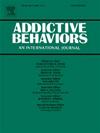Neuromodulation of dorsal and ventral prefrontal cortex during gambling task performance in low and high impulsive individuals
IF 3.7
2区 医学
Q1 PSYCHOLOGY, CLINICAL
引用次数: 0
Abstract
Introduction
Impulsivity has been widely associated to risky decision-making and addictive behaviours. Recent research is investigating transcranial direct current stimulation (tDCS) as a potential tool to improve gambling disorder symptomatology; however, few studies have considered the influence of impulsivity on tDCS effects targeting different brain areas to modulate gambling-related behaviours.
Methods
Two experiments were performed with two-session crossover designs using the same methodology and different samples of low and high impulsive participants (N=64). Multielectrode tDCS montages were designed to target right dorsolateral prefrontal cortex (rDLPFC) and ventromedial prefrontal cortex (vmPFC) during Cambridge gambling task (GCT) performance.
Results
Results showed tDCS effects on CGT in both low and high impulsive individuals, revealing specific findings associated to rDLPFC and vmPFC targets respectively. A potential influence of impulsivity on tDCS effects was suggested by the differences in delay aversion between LI and HI, shown only in real stimulation but not in sham. Low and high impulsive participants showed differences in task performance, especially in the lowest and highest risk conditions.
Conclusion
Future neuromodulation research may benefit from taking into consideration factors including personality traits, such as impulsivity and participants individual differences that may impact the responsiveness to tDCS, as well as from employing neuroimaging techniques to identify the underlaying tDCS effects on specific brain circuits.
低冲动和高冲动个体赌博任务表现中前额叶背侧和腹侧皮层的神经调节
冲动性被广泛地与冒险决策和成瘾行为联系在一起。最近的研究正在调查经颅直流电刺激(tDCS)作为改善赌博障碍症状的潜在工具;然而,很少有研究考虑冲动性对针对不同脑区调节赌博相关行为的tDCS效应的影响。方法采用相同的方法和不同的低冲动和高冲动受试者(N=64),采用两期交叉设计进行两项实验。设计了多电极tDCS蒙太奇,以剑桥赌博任务(GCT)中的右背外侧前额叶皮层(rDLPFC)和腹内侧前额叶皮层(vmPFC)为目标。结果显示,tDCS对低冲动个体和高冲动个体的CGT均有影响,并分别揭示了与rDLPFC和vmPFC靶点相关的特异性发现。LI和HI之间延迟厌恶的差异表明冲动性对tDCS效应的潜在影响,这种差异仅在真实刺激中表现出来,而在假刺激中没有表现出来。低冲动和高冲动的参与者在任务表现上存在差异,尤其是在最低和最高风险条件下。结论未来的神经调节研究可能会受益于考虑人格特征,如冲动性和参与者的个体差异,这些因素可能会影响tDCS的反应性,以及利用神经成像技术来识别tDCS对特定脑回路的潜在影响。
本文章由计算机程序翻译,如有差异,请以英文原文为准。
求助全文
约1分钟内获得全文
求助全文
来源期刊

Addictive behaviors
医学-药物滥用
CiteScore
8.40
自引率
4.50%
发文量
283
审稿时长
46 days
期刊介绍:
Addictive Behaviors is an international peer-reviewed journal publishing high quality human research on addictive behaviors and disorders since 1975. The journal accepts submissions of full-length papers and short communications on substance-related addictions such as the abuse of alcohol, drugs and nicotine, and behavioral addictions involving gambling and technology. We primarily publish behavioral and psychosocial research but our articles span the fields of psychology, sociology, psychiatry, epidemiology, social policy, medicine, pharmacology and neuroscience. While theoretical orientations are diverse, the emphasis of the journal is primarily empirical. That is, sound experimental design combined with valid, reliable assessment and evaluation procedures are a requisite for acceptance. However, innovative and empirically oriented case studies that might encourage new lines of inquiry are accepted as well. Studies that clearly contribute to current knowledge of etiology, prevention, social policy or treatment are given priority. Scholarly commentaries on topical issues, systematic reviews, and mini reviews are encouraged. We especially welcome multimedia papers that incorporate video or audio components to better display methodology or findings.
Studies can also be submitted to Addictive Behaviors? companion title, the open access journal Addictive Behaviors Reports, which has a particular interest in ''non-traditional'', innovative and empirically-oriented research such as negative/null data papers, replication studies, case reports on novel treatments, and cross-cultural research.
 求助内容:
求助内容: 应助结果提醒方式:
应助结果提醒方式:


